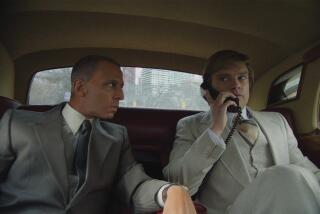From ‘Z’ to ‘Amen.’
WHEN Costa-Gavras, a young Paris-based filmmaker, returned to his native Greece to make his 1969 “Z,” an expose of the military junta’s ruthless seizure of power in 1966, he brought a raw documentary realism to the fast-paced thriller form with such style and urgency that the film became an international classic.
A flurry of political thrillers followed “Z,” capped by Costa-Gavras’ Hollywood debut, “Missing” (1982), in which Jack Lemmon played a father searching for his son in the aftermath of the overthrow of the Allende government in Chile.
Always an astute political observer, Costa-Gavras has delivered his highest-profile picture in years, “Amen.,” which he and co-writer Jean-Claude Grumberg took as its starting point Rolf Hochhuth’s internationally controversial 1963 play, “The Representative,” known in the U.S. as “The Deputy.” It tells of a true-life scientist-physician, Kurt Gerstein, a lieutenant in the SS. He helped developed the infamous Zyklon B to purify the water supply for German soldiers vulnerable to typhus only to discover to his horror that it was being used to gas prisoners in Nazi extermination camps in Poland.
The film, which opens Friday in Los Angeles, is the story of a man who already had a history of anti-Nazi protest and his struggle to get word of the Holocaust to the Allied powers and in particular Pope Pius XII, who he believed would then speak out strongly against Nazi inhumanity. He is aided by a young Jesuit priest, a deft composite character of four such men with close ties to the Vatican.
Costa-Gavras has wanted to make a film inspired by the play ever since he saw it 40 years ago in Paris, where the French adaptation, called “The Vicar,” had been done by novelist-screenwriter Jorge Semprun. “I saw the play at that time because friends of mine, like Michel Piccoli, who played the priest, were participating in it. I went to see the play a couple of times. The amazing thing is that there was an extraordinary line in the play that said, ‘This pope, who stood silent, he’s a criminal person.’ That was a big scandal, to say that. And outside the theater there were people screaming against the people who went inside to see the play. It was a big mess.”
Although he turns 70 on Feb. 13, he has changed little over the decades, remaining trim and handsome. He has long been comfortable speaking English and is a low-key man of unpretentious charm. “When I saw the play, I was a young filmmaker and unknown, and later, when it was easier for me to make it, the rights had already been taken and not freed until five years ago. When I went to see Hochhuth, who was very young when he wrote the play, for the rights, I told him, ‘I will respect its spirit but not the letter. The play is essentially based on the pope, in the Vatican. Most of the scenes are there; there was a lot of discussion about the Vatican -- about all the tragedies, all the massacres and how the pope accepted them, almost promoted them. For me, the pope wasn’t the most important person in the story. The most important people were the two Christians, the priest and the Nazi officer.
“THEY were men of conscience and from inside the system -- that was the important thing. So in the movie the pope became a secondary character, and of course what interests me a lot is how Gerstein is able to go that double way, a man who wanted to expose the horrors but also understood he would also have to serve as a witness to them.”
Much of the power of the film derives from Costa-Gavras’ indirect, implicit approach to cataclysmic events and complex actions. The audience can judge for itself in light of the increasingly self-sacrificing nature of its two central figures, men who reached the point of having to choose between ethics and self-preservation, which for Costa-Gavras is the core of the film.
Costa-Gavras said he read 16 books in preparation for the two years it took him and Grumberg, a veteran of theater and television as well as films, to write the script. Filming inside the Vatican for the sequences that take place there was out of the question, and Costa-Gavras ended up shooting much of the $10-million film in Romania, which provided a wide array of striking settings.
For his two chief characters, Gerstein and the fictional Ricardo Fontana, he chose, respectively, German actor Ulrich Tukur and noted French actor-director Mathieu Kassovitz.
Though the director is already thinking about what to do next -- “I can’t say yet what that will be” -- he feels his patience in getting the film made has been rewarded and is ready to move on.
More to Read
Only good movies
Get the Indie Focus newsletter, Mark Olsen's weekly guide to the world of cinema.
You may occasionally receive promotional content from the Los Angeles Times.










